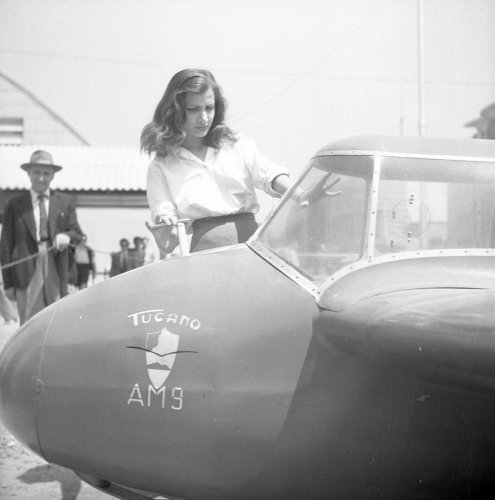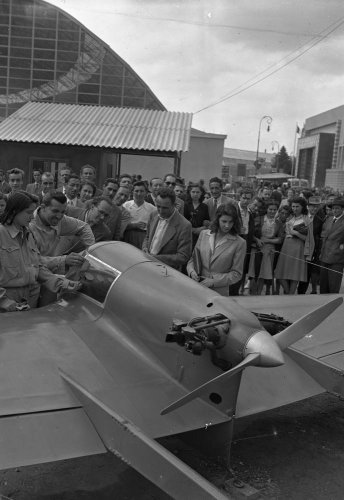- Joined
- 28 January 2008
- Messages
- 631
- Reaction score
- 480
I found the image below in a 1993 issue of Aeroplane Monthly and was intrigued by this design by Adriano Mantelli (b.13 February 1913 d.6 May 1995). Around 35 examples were built between 1949 and 1951.
The AM.75 was an interesting twin-seat light monoplane with a distinctive egg-shaped fuselage. The tailplane had a single fin and rudder was carried on twin booms, either side of a pusher engine installation. The cabin doors hinged upwards and to the rear. The undercarriage was a single mainwheel under the fuselage pod, a small tailwheel behind it, and outrigger wheels on the wingtips.
The aircraft not only found favour with civil operators but also with the Aeronautica Militare who operated 10 examples until 1951.
The Baldo was available with two engine options:
- AM.65 with Walter Mikron piston engine
- AM.75 with Praga D engine
I believe the AM designator refers to Adriano Mantelli although I think he set up Alaparma with Livio Agostini, so it is conceivable that it refers to Agostini-Mantelli in later designs.
General characteristics of the AM.75
Accomodation: 2
Powerplant: 1 × Praga D 56 kW (75 hp) 4-cylinder horizontally-opposed piston
Wingspan: 7.00 m (23 ft 0 in)
Length: 5.08 m (16 ft 8 in)
Height: 1.45 m (4 ft 9 in)
Wing area: 8.5 m2 (91 sq ft)
Empty weight: 280 kg (617 lb)
Gross weight: 490 kg (1,080 lb)
Maximum speed: 217 km/h (135 mph)
Cruising speed at 75% power: 192 km/h (119 mph)
Range: 660 km (410 mi)
Service ceiling: 4,800 m (15,748 ft)
Time to altitude: 5 min to 1,000 m (3,300 ft)
Does anyone know anything more about the pre-war AM.6 design mentioned in the Aeroplane Monthly clipping?
Source:
Jane's All The World's Aircraft 1951–52 Edited by Leonard Bridgman (Sampson Low)
Aeroplane Monthly (October 1993) magazine
The AM.75 was an interesting twin-seat light monoplane with a distinctive egg-shaped fuselage. The tailplane had a single fin and rudder was carried on twin booms, either side of a pusher engine installation. The cabin doors hinged upwards and to the rear. The undercarriage was a single mainwheel under the fuselage pod, a small tailwheel behind it, and outrigger wheels on the wingtips.
The aircraft not only found favour with civil operators but also with the Aeronautica Militare who operated 10 examples until 1951.
The Baldo was available with two engine options:
- AM.65 with Walter Mikron piston engine
- AM.75 with Praga D engine
I believe the AM designator refers to Adriano Mantelli although I think he set up Alaparma with Livio Agostini, so it is conceivable that it refers to Agostini-Mantelli in later designs.
General characteristics of the AM.75
Accomodation: 2
Powerplant: 1 × Praga D 56 kW (75 hp) 4-cylinder horizontally-opposed piston
Wingspan: 7.00 m (23 ft 0 in)
Length: 5.08 m (16 ft 8 in)
Height: 1.45 m (4 ft 9 in)
Wing area: 8.5 m2 (91 sq ft)
Empty weight: 280 kg (617 lb)
Gross weight: 490 kg (1,080 lb)
Maximum speed: 217 km/h (135 mph)
Cruising speed at 75% power: 192 km/h (119 mph)
Range: 660 km (410 mi)
Service ceiling: 4,800 m (15,748 ft)
Time to altitude: 5 min to 1,000 m (3,300 ft)
Does anyone know anything more about the pre-war AM.6 design mentioned in the Aeroplane Monthly clipping?
Source:
Jane's All The World's Aircraft 1951–52 Edited by Leonard Bridgman (Sampson Low)
Aeroplane Monthly (October 1993) magazine




![Décollage___le_magazine_de_[...]_bpt6k9767044h_13.jpeg](/data/attachments/147/147022-8c90ae6315dad29cc97b1d9fb2c0eb19.jpg)


